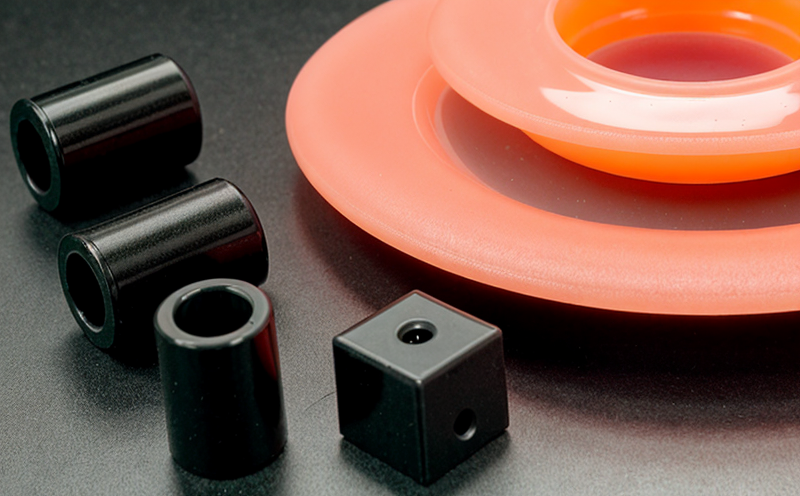ASTM D2990 Creep Behaviour Testing of Plastic Sports Gear
The ASTM D2990 test method is a standardized procedure used to evaluate the creep behavior of plastic materials. Creep behavior refers to the gradual deformation or stretching of material under constant load over time, which is critical in assessing the long-term performance and durability of plastics used in sports equipment.
This testing is particularly important for high-performance sports gear such as helmets, knee pads, and other protective wear where safety and reliability are paramount. The ASTM D2990 test provides crucial insights into how materials behave under prolonged stress conditions, ensuring that the products meet stringent safety standards set by regulatory bodies.
The process involves subjecting a sample of plastic material to a specified load in a controlled environment, typically at elevated temperatures. Over time, the deformation is measured and recorded. The results help manufacturers understand the potential for permanent deformation under real-world usage conditions, thereby enabling them to optimize material selection and design processes.
For sports gear, this testing ensures that the materials used can withstand the rigorous demands of various sports activities without failing prematurely. This is especially critical in contact sports where protective equipment must maintain its integrity through repeated use and exposure to physical stress.
The ASTM D2990 test is not just about compliance with regulatory standards; it also plays a vital role in the continuous improvement of product design. By identifying potential weaknesses early, manufacturers can iteratively refine their materials and manufacturing processes to enhance performance and safety.
- Reduces material waste by optimizing the use of raw materials
- Promotes sustainable manufacturing practices through informed design choices
- Aids in the development of longer-lasting products, reducing environmental impact
- Supports the transition towards more recyclable and biodegradable plastics
In summary, ASTM D2990 creep behavior testing is an essential tool for ensuring that sports gear meets both performance expectations and regulatory requirements. It enables manufacturers to develop safer, more durable products while contributing positively to sustainability goals.
Industry Applications
The ASTM D2990 test method is widely used across various sectors within the sports and leisure industry, particularly for items like helmets, knee pads, and other protective gear. These products must not only provide immediate protection but also maintain their integrity over prolonged use.
In the case of helmets, this testing ensures that the materials can withstand impact forces repeatedly without compromising structural integrity. For knee pads, it helps verify that the material will remain effective even after extended wear and tear during high-intensity activities like skateboarding or inline skating.
The test is also applicable to a variety of other sports equipment where durability and safety are critical factors. These include:
- Protective gear for football, hockey, and rugby
- Bicycle helmets
- In-line skates and rollerblades
- Golf clubs
- Tennis rackets and racquets
The results of ASTM D2990 tests are crucial not only for compliance with industry regulations but also for enhancing the overall quality and reliability of these products. By ensuring that materials can withstand prolonged stress without deforming, this testing contributes significantly to improving user safety and satisfaction.
Customer Impact and Satisfaction
The ASTM D2990 creep behavior test has a direct impact on customer satisfaction by enhancing the reliability and durability of sports gear. For consumers, this means purchasing products that not only meet safety standards but also provide long-term performance under various conditions.
Manufacturers who utilize ASTM D2990 testing can offer customers peace of mind knowing that their equipment has been rigorously tested to ensure it meets or exceeds industry standards. This transparency builds trust and enhances brand reputation, leading to increased customer loyalty and satisfaction.
In addition to safety and durability, the test also plays a role in enhancing product performance. By optimizing material selection based on creep behavior testing results, manufacturers can develop products that not only meet regulatory requirements but also outperform competitors' offerings. This competitive edge translates into higher market share and greater customer satisfaction.
Moreover, the insights gained from ASTM D2990 tests enable continuous improvement in product design and manufacturing processes. This iterative approach ensures that products remain at the forefront of innovation, meeting evolving consumer expectations and safety standards.
Customer impact is further amplified by the sustainable practices supported through this testing. By using materials that exhibit excellent creep resistance, manufacturers contribute to reduced waste and environmental impact. This aligns with growing consumer demand for eco-friendly products, thereby enhancing overall customer satisfaction.





